Dentures and Implant Solutions for Missing All Upper or Lower Teeth in St. Augustine, FL
Tooth loss can significantly impact your comfort, appearance, and quality of life. For patients missing all upper or lower teeth, modern dentistry offers several advanced options beyond traditional dentures. Whether you’re exploring full dentures or implant-supported dentures, choosing the right solution depends on your oral health, bone density, and long-term goals for comfort and function.
At our practice, we provide customized care for those seeking dentures in St. Augustine, FL, with a focus on restoring your complete smile, improving chewing function, and preserving your facial shape. Through a thorough examination and consultation, we’ll help determine the best course of action to replace missing teeth and support long-term oral health.
Although many patients have no problem wearing an upper denture, some people find it difficult to wear and eat with lower dentures. Several implant-supported replacement options are available if you are missing all of your lower teeth.
Traditional Dentures vs. Implant Denture Options
For many years, traditional dentures were the standard solution for full tooth loss. While complete dentures remain a viable choice, they may not provide the stability or comfort some patients need, especially in the lower jaw. Wearing dentures without implant support can lead to sore spots, shifting, and difficulty eating, especially with tougher or firmer foods.
To address these issues, implant dentures have become a preferred choice for many. Even as few as two dental implants can dramatically improve the stability of a lower temporary denture. More advanced options use four to six implants to support an overdenture that snaps securely onto a custom support bar, allowing for much greater retention with less movement during chewing.
Implant Dentures for the Lower Jaw
Ball Attachment Denture
One option is to have two implants placed in your lower jaw and a denture made that snaps onto these implants. This option allows your lower denture to be more stable while chewing than without implants. However, there will still be movement of your lower denture, and sore spots will occur if any food particles, especially seeds, are caught under it. As with all removable replacement teeth, you still will need periodic appointments for denture adjustment.

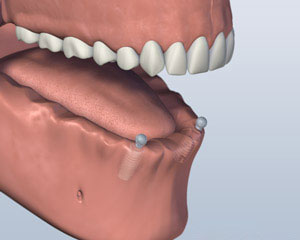
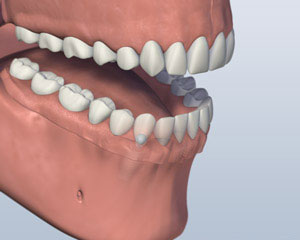
Bar Attachment Denture
Another option involves placing four to six implants, depending on your jaw size or shape, into your lower jaw. After healing is complete, the implants are connected with a custom-made support bar. Your denture will be made with special internal retention clips that attach onto the support bar, enabling the denture to snap firmly into place. This is called an “overdenture.” The advantage of this option is that it is much more stable than the first option and allows very little denture movement. Your denture is still removable for easy cleaning and maintenance.
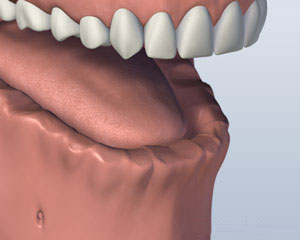


Screw Retained Denture
A third option involves placing five or more implants in your jaw and attaching a permanent denture. Your denture is held in place by screws or clasps that secure it to the support posts or bar. It doesn’t touch the gum tissue, which allows you to clean under the denture without removing it. This denture will replace all your missing lower teeth and will not be removed except at maintenance visits. Although cleaning under your denture without removing it is more time consuming and requires more dexterity, many patients who want a permanent denture prefer this option.
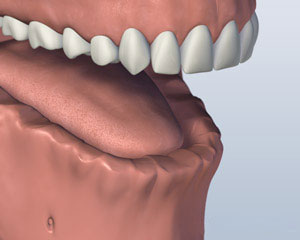
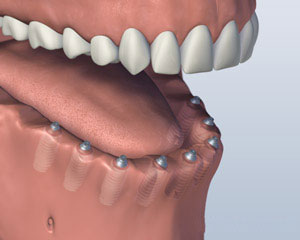
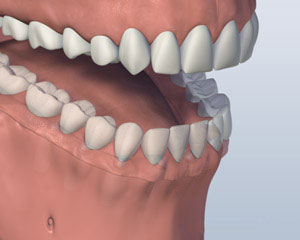
Individual Implants
The final option is to have all your teeth individually replaced so that they will appear to be growing out of your gum tissue and will most closely resemble the appearance of your natural teeth. This option usually requires eight or more implants. Separate abutments or support posts for each one of these implants will be made and crowns for each missing tooth will be placed. The teeth are often joined together for sinus grafting to replace bone height strength and support. Overall, this is the most costly option, because it requires the most implants and individual replacement tooth fabrication. Your replacement options may also be limited by the current size and shape of your jawbone.
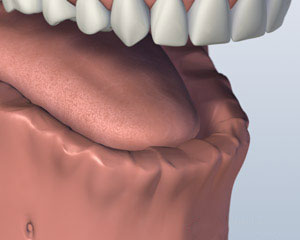
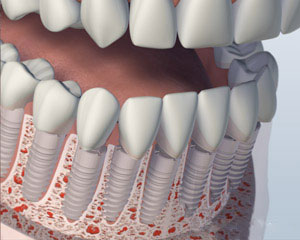
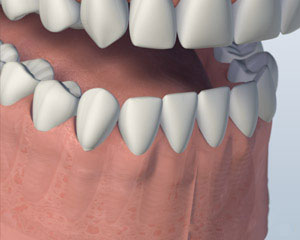
Implant Dentures for the Upper Jaw
Treating tooth loss in the upper jaw often requires more implants due to the bone’s softer texture. In some cases, this allows us to eliminate the need for a complete denture that covers the roof of the mouth, restoring your ability to taste and sense food temperatures more naturally.
Whether you choose removable or fixed options, implant dentures for the upper arch can restore your ability to eat, speak, and smile with confidence. We’ll evaluate how many teeth need to be replaced and whether your bone structure can support implant placement, using advanced imaging and thorough examination.
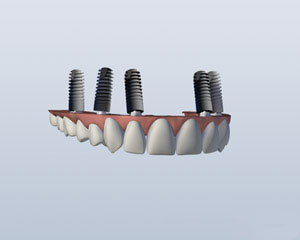
Implant Retained Upper Denture
Depending upon the number of implants to be placed, it may be possible to eliminate the need for covering the roof of your mouth with a complete denture. This option allows you to fully taste your food and gives you a better sense of its temperature. Your denture will feel more natural. You will still have a removable denture, which makes cleaning the support bar and denture much easier.

Individual Upper Implants
If you want a restoration that is similar to your natural teeth and therefore not removable, you probably will need eight to ten individual implants placed. This is followed after healing by the placement of the abutments and new replacement crowns.
Maintaining Your Dentures and Oral Health
Regardless of which solution you choose, daily care is essential. For removable prosthetics, use a denture cleanser and soak them overnight. Brush your gum tissue, tongue, and remaining natural teeth with a soft bristled toothbrush to maintain good oral hygiene. Regular dental visits help monitor the condition of your dental implants, gum health, and overall fit of your prosthetic.
If you opt for new dentures, we’ll provide detailed care instructions and help you adapt to the feel and function of your artificial teeth. Your provider will also review whether changes to your diet, such as focusing on softer foods, may be beneficial during your adjustment period.
Denture Consultation and Cost Considerations
During your denture consultation, we’ll review all possible treatment options, including the number of new teeth implants required, expected healing time, and any procedures needed to prepare the jawbone. We’ll also discuss how your medical history may affect your treatment plan, as well as ways to make your dental care more affordable.
While denture costs can vary depending on the materials, number of implants, and complexity of care, we’ll provide you with a clear outline of pricing and available financing options. Our goal is to help you regain your smile in a way that fits your needs and lifestyle.
If you’re exploring partial dentures, full dentures, or implant-supported dentures in St. Augustine, FL, schedule your consultation with our experienced team today at 904-460-0505. Together, we’ll create a custom denture solution to restore function, appearance, and your confidence.